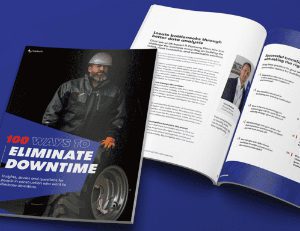

Here’s a thought. Do you ever wonder why you’ve bothered sorting your plastics from your cardboard, jumped on the bike instead of the car for your daily commute or taken your own cup to the local coffee house to cut down on paper waste?
It’s probably crossed your mind more than once if it’s really worth the effort, especially on a cold winter’s morning. And yet we do it, we persist and we take a perverse kind of pleasure in doing our bit.
And we do it, even when someone whizzes by you and your fellow helmeted riders in their four-wheel drive or you spot someone dumping their rubbish in the wrong place in the recycling center. We do it, because we care and we still want to create that sense of being part of a collective. And it’s all in aid of an overall contribution that can make a mark on the macro environment.
That’s kind of where we are with construction. Many of us are taking steps in our daily working lives that are making small differences. Tracking this. Streamlining processes there. Utilizing human resources better. And connecting up job sites for more effective fleet management.
Yet when it comes to emissions reporting, we’ve also allowed a practice to develop where, because it’s based on inadequate data, companies can publish estimated numbers that, at best, might be considered good marketing and at worst, are misleading. It’s a practice in guesswork that undermines the collective effort, harms the industry and can only be put right by implementing live tracking for emissions data.
Here’s some figures to consider. Last year’s COP27 climate talks included a dispiriting UN report on construction that showed the industry had rebounded from the COVID-19 pandemic to post record highs in energy consumption and CO2 emissions at 34% and 37% respectively. And those figures — approximately 2% above 2019 levels — came despite significant energy efficiency investments and concerted efforts to lower energy intensity.
‘We’ve also allowed a practice to develop where, because it’s based on inadequate data, companies can publish estimated numbers that, at best, might be considered good marketing and at worst, are misleading.’
The implication from that is obvious. Whatever they might be saying about their emissions something is being lost in translation. That being so, what then should we do?
First, we have to acknowledge that the practice of reporting numbers in favorable terms has developed because emissions tracking and reporting standards in our industry is immature and is, in comparison with gathering on-road data, difficult to do. But progress is being made on the legislative side and, while there are as of yet no rigorous standards for calculating emissions, these legislative steps are critical to the shift in behaviors.
The United States has, for example, been making significant strides implementing regulations to reduce CO2 emissions from the transportation sector. The country has implemented fuel economy standards for passenger cars and light-duty trucks and has set targets for reducing emissions from heavy-duty vehicles. The current US administration has also announced plans to reduce the country’s greenhouse gas emissions by 50-52% by 2030 compared to 2005 levels.
At the federal level, things are happening too. California has set a target of reducing greenhouse gas emissions by 40% below 1990 levels by 2030, with a goal of achieving carbon neutrality by 2045. Further, it has in the last month tightened legislation on electric equipment that requires fleets to report on actual energy usage of machine, rather than estimating usage. Other states, such as New York, Massachusetts, and Illinois, have also introduced their own emissions reduction targets.
The European Union has also been highly active in implementing regulatory requirements. The European Commission’s European Green Deal aims to make the EU climate-neutral by 2050, with a 55% reduction in greenhouse gas emissions by 2030. As part of this initiative, the EU has introduced the Construction Products Regulation, which requires the construction industry to assess the environmental performance of its products, including their CO2 emissions.
‘The regulatory environment is becoming more and more established and is underpinned by a societal sentiment that is more or less in harmony with those goals.’
Elsewhere, international organizations like the World Green Building Council are working to promote sustainable construction practices globally. The WGBC’s Advancing Net Zero initiative aims for all buildings to halve “emissions of the building and construction sector by 2030 and the total decarbonisation of the sector by 2050,” and it provides resources and guidance for companies looking to reduce their carbon footprint.
This all adds up. The regulatory environment is becoming more and more established and is underpinned by a societal sentiment that is more or less in harmony with those goals. When that happens, the criteria to be part of government-, state- or regional-funded projects becomes ever more stringent in line with macro targets that enjoy broad support through society.

And that places a premium on bidders being able to demonstrate they really are on the right side of the line when it comes to demonstrating their record on emissions. It is in effect the perfect marriage of business sense and an environmentally friendly strategy that should encourage better behavior and better outcomes.
Which leads us to technology. We are already living in an incredibly data-rich environment that has taken huge strides in the last few years with the advances in IoT and the deepening connectivity between machines, people and processes.
And the next breakthrough on delivering data that really can make a difference to fleet owners at the micro-level is upon us. There are exciting things that are happening that will make emissions reporting more quantifiable, more rigorous and, perhaps most significantly for the bottom line, aligned with the kind of stringent criteria that will enable them to successfully bid for lucrative, environmentally-friendly contracts.
The good news is that as every machine on every job site in the world gets closer to being connected to the internet it will be possible to take a data-driven approach to highly accurate CO2 emissions reporting based on real data for each and every asset, even without access to highly detailed utilization datasets.
To establish rigorous reporting standards, it will take collaboration between governments and private players, with trailblazers showing the way.
To get ahead of the both the legislation and the competition, it is crucial for construction machine fleet owners to start implementing detailed reporting standards based on real machine utilization data and local power mix profiles for electrical equipment. This will require some effort and resources, but it is a necessary step in ensuring sustainable development in the construction industry.
‘There are exciting things that are happening that will make emissions reporting more quantifiable, more rigorous and…aligned with the kind of stringent criteria that will enable them to successfully bid for lucrative, environmentally-friendly contracts.’
And more and more major industry players are relying on state-of-the-art telematics providers with the sophistication to handle the highly complex modeling of individual machine profiles to provide a future-proof CO2 reporting setup. By being proactive and staying ahead of regulations, companies can reduce their emissions, save money, and contribute to a sustainable future.
So, while progress is being made in regulating CO2 emissions in the construction industry, there is still a long way to go in establishing rigorous reporting standards. But it is happening. And through collaboration between governments, private players, and initiatives like the Advancing Net Zero campaign, the shift towards a more sustainable construction industry will happen.
Live-tracking of emissions will enable us to get there. And getting there is about pulling together. It’s the very least we can do.
To receive three insightful reads on data, strategy and tech from people across the construction industry in your inbox once a month, sign up to the Eliminate Downtime newsletter.

Never miss an insight. We’ll email you when new articles are published on this topic.

